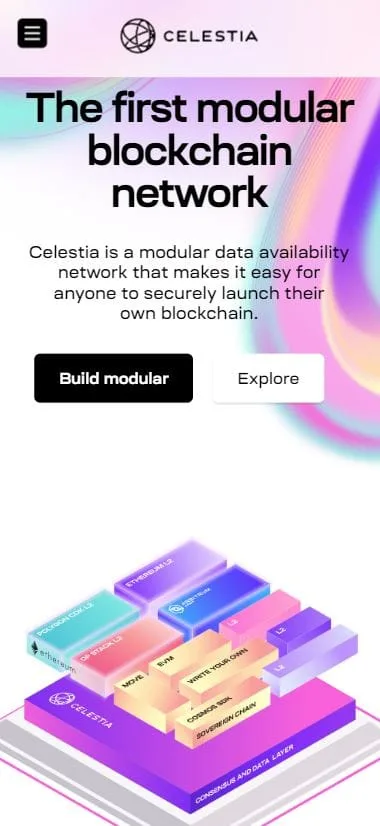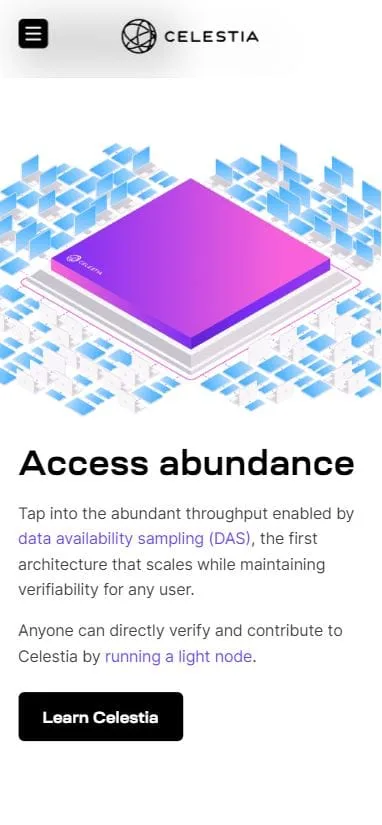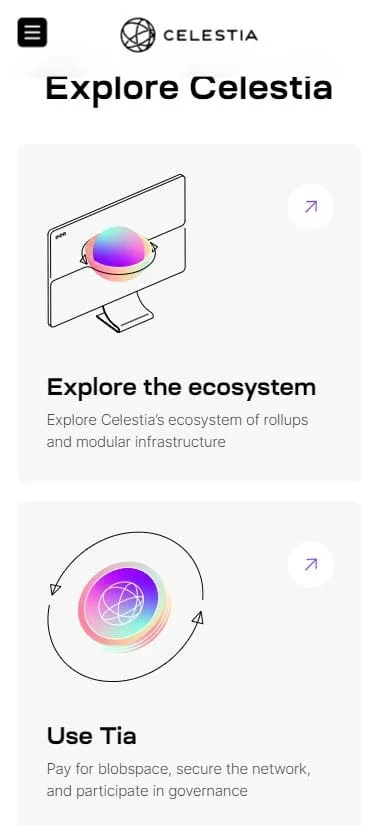About Celestia (TIA)
What is Celestia (TIA)?

Celestia (TIA) is a modular blockchain network built using the Cosmos SDK. It is designed to offer an innovative solution to the scalability and flexibility challenges faced by traditional blockchain systems. By separating the consensus layer (data availability and ordering) from the execution layer (transaction processing), Celestia provides a highly scalable, customizable environment for developers. This architecture enables the creation of specialized blockchains and decentralized applications (dApps) with minimal overhead and greater flexibility.
The native token of the Celestia network is TIA, which serves various functions within the ecosystem, including gas fee payments, network governance, and staking participation.
How does Celestia (TIA) work?
Celestia operates with a modular design, a departure from traditional monolithic blockchains that combine consensus, execution, and settlement layers in one system. By decoupling these layers, Celestia offers several key advantages:
- Data Availability Sampling: Celestia introduces a technique called data availability sampling, which enables nodes to verify that data is available for a block without needing to download the entire block. This reduces the computational and storage burden on individual nodes while ensuring that data is accessible and verifiable. It helps maintain scalability and decentralization without compromising security.
- Modular Blockchain Architecture: Celestia’s architecture separates the consensus (data availability and ordering) and execution layers. The Optimint protocol provides the settlement layer, allowing developers to focus solely on building the execution layer of their blockchain applications. This modularity allows Celestia to be a highly flexible and scalable solution for developers.
- Decoupling Execution from Consensus: Celestia’s design allows the execution of transactions to be separate from the consensus process. Developers can define their own execution environment, providing full control over transaction processing and the rules of their blockchain applications. This enhances customizability and allows for more specialized use cases.
- Scalability without Compromising Security: By separating the consensus and execution layers, Celestia ensures that the network can scale efficiently, even as more applications and blockchains are added to the ecosystem. Its unique approach enables it to support multiple application-specific blockchains while preserving security and decentralization.
What are the potential use cases for Celestia?
Celestia’s modular architecture opens up a wide array of potential use cases:
- Custom Blockchain Deployment: Developers can easily deploy their own blockchains on Celestia, benefiting from the network’s security and data availability without the complexity of managing a full blockchain stack. Whether for general-purpose applications or application-specific blockchains, Celestia provides the flexibility to experiment and create custom solutions.
- Data Integrity and Availability: Since Celestia focuses on ensuring the availability and integrity of data, it is a good fit for use cases requiring high levels of data security. Applications in fields like finance, healthcare, or supply chain management, where data verifiability and access are critical, can benefit from Celestia’s modular architecture.
- Cross-Chain Interoperability: Celestia’s modular approach also facilitates the development of interoperable blockchain ecosystems, where different chains can easily interact with one another, sharing data and assets. This could be particularly useful for decentralized finance (DeFi) applications and cross-chain communication.
- Decentralized Applications (dApps): Celestia provides a scalable and customizable platform for building decentralized applications that require unique execution environments or specific rules. Developers have the freedom to design their own smart contract environments and consensus mechanisms, tailoring the platform to their specific needs.
What is the history of Celestia?
The idea behind Celestia originated from a desire to rethink blockchain architecture. The project was inspired by the limitations of traditional monolithic blockchains, which bundle consensus, execution, and settlement functions together, causing bottlenecks and scalability issues. Celestia aims to address these challenges with its modular design.
The initial concept for Celestia was articulated in the “LazyLedger” whitepaper, written by Mustafa Al-Bassam, a computer science researcher at University College London. This paper proposed a distributed data availability ledger that focuses solely on ensuring data availability and ordering, while leaving execution and smart contract functionality to client-side systems. The concept evolved into Celestia, which became the first modular blockchain network designed to separate consensus and execution.
Celestia represents a significant step forward in blockchain design, offering greater scalability, flexibility, and customizability for developers. The project continues to push the boundaries of blockchain technology with its unique approach to modularity and data availability.





















Reviews
There are no reviews yet.